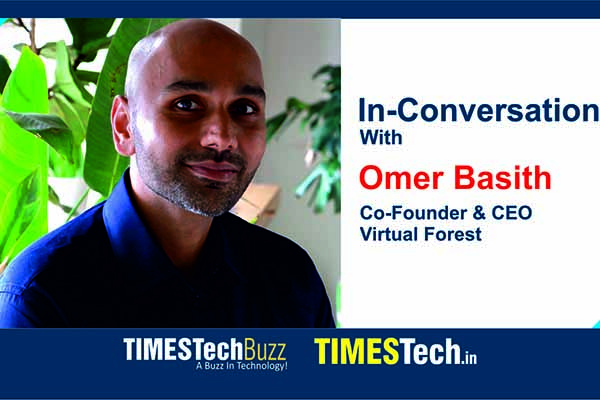Through its integrated partner platform, Virtual Forest powers the Home Appliance and EV ecosystems, which includes cutting-edge in-house R&D (for design, testing, and integration), world-class manufacturers (EMS partners), and leading global distributors of semiconductors, PCBs, and electronic components. Timestech spoke with Omer Basith, Co-founder and CEO of Virtual Forest, about the hurdles they experienced as a small start-up, connecting with large manufacturers’ supply chains, the future, and much more.
Read the edited excerpts from the interview here:
TimesTech: Tell us about what Virtual Forest does. What is its core expertise, which sector it caters to and what product and services it offers?
Omer: Virtual Forest specializes in motor control and human interface solutions exclusively and we work on technologies that help reduce emissions. We are also working towards goals like the electrification of mobility and other opportunities that help reduce emissions.
So, our mission and our vision statement are motor control solutions for the journey to NetZero. Now the journey to Net Zero has a couple of well-established pathways which have been designed and agreed upon by most people. So, the first part is residential and industrial energy efficiency. The first application that we went after was air conditioning, specifically, air conditioners for residential use in India. So, we now have a solution for inverter air conditioners in mass production since last financial year and we are manufacturing products ranging from 1 ton up to 3.2-tons at this juncture.
The second application that we went after in energy efficiency was BLDC ceiling fans. 1st January onwards, non-star rated fans will no longer be sold and that indicates a huge change because as per the current energy efficiency norms of the fan, a five-star rated induction motor fan consumes about 55 Watts at level 5 full speed. The new legislation will require that a one-star rated fan consume a max of 50 volts. So, that means anything above that will most likely be shifting to BLDC.
We have several other applications which will enter production this year that includes solutions for inverter washing machines, solutions for solar pump controllers and solution for inverter mixer grinders.
In the later part of this decade, we hope to be doing significant work in industrial applications as well as working on new applications in newer, more efficient, more cost-effective designs for residential applications as well.
The second energy pathway is Electric Mobility. This is another area in that we are doing significant work. Of course, the first application that we are working on now is for two-wheelers motor drives to serve the low-speed two-wheeler segment that is already in validation with some of India’s large motor manufacturers.
We have won the contract to develop the global platform for a 3-kilowatt to 15-kilowatt controller for high-speed two-wheelers and three-wheelers from NXP. So, this is a significant win and a great validation of our capability in this space we’re working with these companies to develop a controller which will be distributed exclusively by them for three years and the IP will remain with Virtual Forest and moving past that we are in development also for a controller for medium logistics applications this will be for one ton plus payload. This is a significant technology project as well, which we will be announcing shortly.
A third pathway that we hope to start working towards in the later part of this decade will be motor control solutions for applications like direct air capture or large-scale air purification.
TimesTech: What are the challenges you faced as a new start-up in the market and the opportunities you got?
Omer: For any start-up that is trying to open it in this space, mainstream parties in India are a challenge. India can become one of the manufacturing powerhouses in the world. We have a couple of key geopolitical reasons for that to happen. Now, it’s up to the Indian industry to make the most of that. It is up to India to make sure that we grab this opportunity with both hands and make sure that we get a large portion of that manufacturing opportunity that shifting out of China. The second huge opportunity is climate change which is going to be the key driver of technology. So, it is something that we discover and worked on. It is a technology problem.
So, the opportunities are certainly Make in India, technology to combat climate change and growing consumption that our country presents.
TimesTech: Do you find it easy to enter the supply chains of big manufacturers?
Omer: The reality is unlike a lot of other countries, the large companies in consumer electronics in India are Indian companies. Voltas has over thirty percent market share of Indian residential air conditioning industry, as far as ceiling fans are concerned Crompton has over 24 percent market share in the Indian ceiling Fan industry.
It is extremely difficult to become a part of these companies’ supply chains. To begin with, an upstart who does not have an existing track record in the market, getting a company that will have to tie their reputation and the performance of the product to you, that is difficult for anybody in the market. But we have been fortunate that companies have given us an opportunity and I think, the good work that our team has been able to do on the technology side and possibly the service side has helped us break in.
In the last couple of years, we have managed to create a successful track record of delivering certain technologies which would otherwise have been exclusively imported. And now that we have a bit of a track record in place, we also can now go to our clients, which technology differentiates them as well.
TimesTech: Where do you source your raw material from and what are the challenges considering the geopolitical situation?
Omer: The shortages of semiconductors have been so well documented and have been in the mainstream news cycle for a long time. Now I feel the opposite and we might be headed towards a glut. There is a significant reduction in consumption. This is a complete U-turn from what it was like for a little while. Now, in terms of where we are procuring our components from? There is no way around the fact that the component manufacturing ecosystem is mostly centered around China and Taiwan to a large extent. We are dependent on imports from these regions for our requirements.
It’s going to be some time before the component ecosystem is localized. Having said that there are still large components that are localized.
TimesTech: How you are competing with imports in the terms of price?
Omer: Price increase is something that has been a global phenomenon. So, it is very likely that our competitors in other countries have also experienced similar sorts of price increases. I think the price of consumer electronics has seen an upward trend. There has been a certain lag between the price increase to the end customer versus the input price increases and effects the margins. The current strengthening of the dollar is something that is impacting companies as well as the state.
TimesTech: What are your plans moving forward?
Omer: We have defined certain technology pathways the first of which being Energy Efficiency and the second being electrification of mobility and the third being applications for director capture etc. We will be working on applications of these technologies. We are going to be working more on IP as a differentiator rather than just cost advantages.















